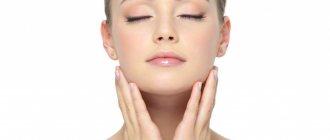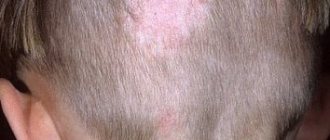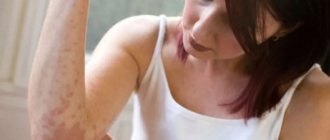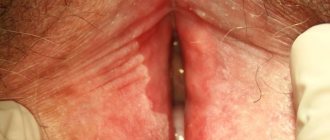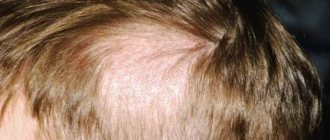Pityriasis versicolor is a fungal infection of the skin with certain symptoms that occurs as a result of the malassezia fungus entering the body. It is often diagnosed in countries and regions with warm to hot climates, which is why it is called beach lichen.
This skin disease appears in adolescents and young adults (it is extremely rarely diagnosed in preschool and retirement age), but people prone to dermatomycosis are also at risk. The disease is long-term and protracted; relapses occur (especially in the hot season, regardless of the region of residence), so it is often called chronic.
Ringworm, like many fungal and viral diseases, is rarely a serious threat to life, but it can indicate health problems and reduce quality of life, especially affecting a person's psychological state.
What is pityriasis versicolor
Pityriasis versicolor, or pityriasis versicolor, is a chronic skin disease of a fungal nature. It appears in the form of specifically pigmented spots of various sizes and shades, without signs of inflammation. Most often, the areas affected by pityriasis versicolor are located on the body (back, abdomen, neck, shoulders) and scalp. Representatives of both sexes are most susceptible to the disease at a young age, and children under 7 years of age are the least susceptible.
External manifestations of the disease usually do not cause concern, so they are often perceived as harmless cosmetic defects. For this reason, the pathology becomes chronic: spots periodically appear, then disappear, and after some time, under the influence of provoking factors, the disease worsens again.
What does lichen look like in humans?
The external manifestation of the pathology is obvious - lichen is accompanied by a number of signs:
- rash in the form of spots of different colors - red, pink, brownish, yellow;
- itching, burning, unpleasant (painful) sensations;
- scales, bubble formations on spots;
- bald spots on the head in the hairline area (clipping form);
- fever (rare);
- malaise, lethargy.
Symptoms of the disease
When infected with pityriasis versicolor, the pathogens multiply in the superficial layers of the skin, disrupting the normal functioning of cells. First of all, melanocytes, which are responsible for the production of the pigment melanin, are affected, thanks to which the skin has one color or another. This means that under the influence of pathogenic microorganisms, the affected areas acquire an uncharacteristic, painful shade. Hence the second name for pityriasis versicolor - versicolor.
The main symptoms of pityriasis versicolor include:
- Spots of yellow, coffee, scarlet or dark brown shades, located mainly on the back, head and neck, shoulders and stomach. In children, they also appear on the limbs, armpits and scalp. The affected areas can be of different sizes, but usually their size does not exceed 1 cm. Subsequently, the spots merge with each other, forming significant areas of the affected skin.
- No signs of inflammation in the form of redness, swelling, hyperemia and pain to the touch.
- Severe peeling of the skin in infected areas, aggravated by touch.
- No tanning on the affected areas.
Pityriasis versicolor is not characterized by itching and discomfort, so patients often mistake the manifestations of the disease for minor cosmetic defects, postponing a visit to the doctor and full treatment.
Such spots begin to itch and scratch only if a secondary infection occurs.
Symptoms of white lichen
What do the rashes characteristic of pityriasis alba look like?
- in the form of a spot or slightly raised above the skin level;
- color: pale pink, nude, dull shades of white;
- there is peeling, but it is light, and the scales themselves are small, easily torn off, and tender;
- the shape is unclear, the boundaries are blurred;
- there is no symmetry;
- when pressed, the color and shape of the stain are preserved;
- small size: from 0.5 cm to 5 cm, usually no more than 2 cm;
- location - face, neck, back, shoulders and upper half of the body;
- itching is not typical, and if there is, it is mild;
- tendency to merge spots - absent;
- quantity: any, depending on the individual characteristics of the disease [1].
It is worth talking separately about the dynamics of the development of rashes with lichen alba. Typically, spots are noticed earlier by people with pigmented skin. They begin to worry about the cosmetic effect. In summer, the affected areas do not tan and may turn red. The rash goes through several stages of transformation during its existence. This usually happens in a few weeks, more often in a year or a little longer.
Stages of development of white lichen:
- a pinkish spot with active peeling, raised above the surface, roughness felt to the touch;
- the spot continues to rise, but turns pale, peeling decreases, and signs of hypopigmentation appear;
- the surface is compared to healthy skin, the color continues to remain paler than the surrounding tissue;
- the color gradually evens out and the defect disappears.
A typical case of pityriasis alba goes away spontaneously on its own, leaving no trace.
There are atypical cases of pityriasis alba: extensive and pigmented, but they should be discussed separately [4].
Reasons for development
Versicolor versicolor is a type of fungal skin infection that affects the stratum corneum of the epidermis and hair follicles. Its causative agents are two types of fungi, and infection is possible only through prolonged and close contact with the patient. And in this case, provoking factors play a big role. These include:
- weakened immunity;
- hyperhidrosis;
- disruption of the sebaceous glands;
- diseases of the endocrine system (obesity, diabetes, Itsenko-Cushing syndrome, etc.);
- hormonal imbalance due to pregnancy, menopause or taking hormone-containing medications;
- vegetative-vascular dystonia;
- abuse of antibacterial personal hygiene products;
- excessive exposure to ultraviolet rays (intense tanning, frequent visits to the solarium) and regular overheating of the body.
It is noteworthy that patients with pityriasis versicolor over 60 years of age are extremely rare. This is due to natural age-related changes in the skin, which make it less susceptible to pathogens.
In children under 10 years of age, the main causes of pityriasis versicolor infection are neglect of personal hygiene rules or improper skin care. At this age, with the protective functions of the skin intact, the body independently copes with pathogenic microorganisms attacking it, so the development of the disease does not occur. But closer to adolescence, when hormonal changes begin, the body’s susceptibility to bacteria, viruses and fungi increases, so children over 10 years old become infected with pityriasis versicolor just like adults.
Treatment of white lichen
We hasten to please patients: pityriasis alba is considered a benign disease and goes away on its own even without treatment. Another thing is that this will take time: months or even years. If the stains are on areas of the skin hidden by clothing, this does not raise any questions. But if the rash is located on the face and neck, then it is more difficult to tolerate. Especially in adolescence and young adults, when increased attention is paid to aesthetics.
How to treat pityriasis alba? General recommendations:
- cover the rash from direct sunlight (hypopigmented spots contrast too much with tanned skin, sunburn is possible at the site of depigmentation);
- use moisturizing creams to reduce flaking;
- Apply sunscreen to exposed areas before going outside.
If the lesions are extensive or you don’t want to wait for the pityriasis alba to go away on its own, you can use the types of treatment recommended by your dermatologist.
Treatment of pityriasis versicolor
The diagnosis of pityriasis versicolor is made to the patient after examination by a dermatologist and dermatoscopy. Additionally, an iodine test and laboratory testing of scrapings can be used.
Treatment of pityriasis versicolor is carried out on an outpatient basis until the symptoms of the disease completely disappear. If measures were taken on time, the patient is prescribed local therapy using antifungal ointments and special agents for exfoliating dead cells.
Additionally, immunomodulators, vitamin complexes, antifungal shampoos and antihistamines are used if the patient is bothered by itching. In the most advanced cases, antimycotic agents are prescribed for oral administration. In addition, in order to avoid relapse of the disease and infection of others, the patient’s clothing and bedding are treated with disinfectant compounds.
Disease prevention also plays an important role. The following will help prevent the development of the disease:
- timely solution to the problem of hyperhidrosis (use of medicinal deodorants, creams, powders, compliance with personal hygiene rules, frequent changes of underwear, etc.);
- use of high-quality soaps and skin care products;
- regular water procedures;
- wearing clothes made from natural, hypoallergenic materials;
- avoiding stress;
- balanced diet rich in vitamins and microelements.
Experts also recommend avoiding overheating of the body and promptly seeking advice from cosmetologists and dermatologists in order to identify the problem and begin proper treatment.
What can be confused with pityriasis alba?
In some cases, it is necessary to differentiate lichen alba with the following pathologies:
- vitiligo;
- contact and atopic dermatitis;
- post-inflammatory hypopigmentation of any origin (including after the use of drugs);
- fungal infections;
- shingles;
- depigmentation of nevus (anemic nevus);
- psoriasis;
- seborrhea;
- pityriasis rosea;
- discoid and nummular eczema [1,3].
What is erythrasma
Erythrasma is a chronic bacterial disease affecting the epidermis layer in the deep folds of the skin. It is characterized by a long course - in some cases, symptoms develop for at least 10 years, without causing significant discomfort to the patient. The clinical picture of erythrasma is similar to a fungal infection of the skin, but modern dermatology classifies it as a group of pseudomycoses.
The following main stages are distinguished in the development of the disease:
- Progression. The first characteristic spots appear on the skin, their size slowly increases, and additional symptoms develop. In some cases, secondary infections occur. The spots gradually merge with each other, forming large areas of damage.
- Stabilization. New spots do not appear, and existing ones stop growing. Peeling of the skin begins. This stage is usually associated with a change in external conditions, for example, cold weather, during which the intensity of sweating decreases and the skin condition stabilizes.
- Exacerbation or relapse. Usually associated with the beginning of the warm season. But in the case of prolonged erythrasma, the disease constantly develops in waves, and after a slight decline its symptoms again actively appear.
- Remission. Occurs with a favorable microclimate, compliance with preventive measures and proper skin care. The color of the affected areas gradually returns to normal, itching and flaking disappear, and the skin is restored.
Without timely, well-chosen treatment, erythrasma can lead to the development of serious complications.
For example, it can provoke eczema and secondary infection in patients with diabetes or obesity. Also, the course of the disease is aggravated by increased humidity and contamination of the affected areas. As a result, its typical symptoms are complicated by burning, itching and pain.
Diagnostics
Diagnosis of white lichen, first of all, consists of taking into account the external manifestations of the disease. If a person has very fair skin, then the white spots on the body may be almost invisible. In this situation, the patient's skin is examined using a Wood's lamp .
A biopsy of the lichen spot can reveal the absence of pigment cells. But it is also worth noting that their presence cannot rule out the diagnosis. Lichen alba must be differentiated from secondary hypochromic changes, which can occur in the presence of certain skin diseases.
Signs of the disease
Externally, erythrasma manifests itself in the form of light brown, brick-red, brown or yellow-brown spots on the skin, most often round in shape and without signs of inflammation. The diameter of the lesions can reach several centimeters, and they tend to merge, forming large affected areas. First of all, erythrasma spots appear in the folds of the skin, where there is a favorable environment for the proliferation of bacteria.
In addition to spots, erythrasma is characterized by:
- Peeling of the skin on the affected areas, aggravated by touch. Usually this is where the development of the disease begins.
- Mild, irregular itching. It intensifies and begins to cause significant discomfort only if a secondary infection is added to the primary disease.
- Absence of fever, wounds, ulcers and ulcers with copious discharge. This distinguishes erythrasma from most bacterial skin pathologies.
- Getting wet. An optional symptom, the manifestation of which depends on the amount of sweating and the quality of skin care.
It is noteworthy that in children, symptoms of erythrasma appear extremely rarely. The risk group includes adults, primarily men, who are predominantly overweight and prone to excessive sweating. In this case, in men, the skin in the groin, navel and inner thighs is usually affected, and in women, the entire abdomen, armpits and areas under the breasts are affected.
What is pityriasis alba?
Pityriasis alba (doctors call it pityriasis alba) is a skin condition that most often occurs in children, teenagers, and young adults. Such rashes have been known since ancient times; Hippocrates called them “pityriasis,” which translated from Greek meant “covered with small bran.”
The exact reason for its appearance is unknown. The disease manifests itself as white or pale pink, dry, slightly flaky spots on the skin. They can have a round or oval shape. After the spot disappears, a patch of hypopigmented white skin remains in its place [1].
Causes of pathology
Corynebacteria, which are the causative agents of the disease, are normally always present on human skin. Moreover, they provoke the development of pathology only under certain, favorable conditions. Corynebacteria do not penetrate deeper than the epidermis, and also do not affect nails and hair. Since the appearance of erythrasma is directly related to increased sweating, the disease most often manifests itself in the hot summer season.
Among the main reasons for the development of erythrasma are:
- hyperhidrosis;
- deviation of the normal pH of the skin to the alkaline side;
- diaper rash, constant friction and mechanical damage to the skin;
- dermatitis and other skin diseases;
- neglect of personal hygiene rules;
- wearing synthetic, overly warm clothing;
- the use of low-quality care products or the abuse of soap with an antibacterial effect, which destroys the natural protection of the skin.
Erythrasma is transmitted by contact, most often after the use of clothing, bedding and personal hygiene products of the patient. You can also become infected during sexual intercourse, when visiting a pool or bathhouse, and when walking barefoot on the ground or beach. At the same time, it is not always possible to accurately determine the source of infection, because the carrier may not have obvious external manifestations of the disease in the form of characteristic spots and peeling.
Causes
At present, the exact causes of pityriasis alba have not been established. Doctors say that the darker a person’s skin, the greater the likelihood of developing pityriasis alba.
Lichen alba in most cases occurs due to:
- Constant stressful situations
- Existing chronic organ diseases
- Intoxication
- Skin contact with synthetics
- Physical damage to the skin
Pityriasis alba often occurs in people who:
- Have thyroid disease
- Suffer from dysfunction of the pituitary-gonad system
- Suffer from increased blood clotting
- Suffering from anacid gastritis
- Suffer from atherosclerosis of the vascular system
- Suffer from asthenia and nervous system exhaustion
Treatment of erythrasma
To diagnose a patient with erythrasma, a dermatologist first uses a visual examination. This is especially true for rashes in the groin area, which have characteristic distinctive features in the form of pronounced protrusions and bubbles along the edges. Also, the affected areas of the skin are illuminated with a Wood's lamp and a microscopic examination of the scraping is performed to exclude other diagnoses: pityriasis versicolor or pityriasis rosea, candidiasis, dermatitis or eczema.
Treatment of erythrasma is primarily based on the use of antibacterial ointments that are used to treat the affected areas of the skin.
Under their influence, corynebacteria die, and the spots gradually lighten, decrease in diameter and disappear. On average, such therapy takes at least 7-10 days. Used in parallel:
- Antiseptics. Treatment with them is carried out before applying antibacterial ointment, as well as after it, to maintain dryness of the affected areas and prevent re-infection.
- Antifungal drugs. They are prescribed together with antibacterial drugs, since corynebacteria are similar in structure to fungal micelles.
- Exfoliating ointments. They help cleanse the skin of a layer of dead cells, activating its regeneration.
- Ultraviolet irradiation. Promotes skin disinfection and restoration. Patients benefit from both natural sunbathing and physiotherapeutic UV irradiation.
If the disease has not reached an advanced stage, the use of external medications is sufficient to solve the problem. But in some cases, with multiple skin lesions, to obtain the desired result, patients are prescribed systemic antibacterial therapy.
Diagnosis of lichen alba
Patients turn to doctors on their own, as in most cases they are concerned about the appearance of unusual rashes that cause them anxiety. Usually they turn directly to dermatologists, less often to pediatricians or therapists. Making a diagnosis, as a rule, does not cause difficulties for a specialist, since the symptoms of pityriasis alba are very characteristic. Already at the first appointment, without resorting to additional examination methods, the dermatologist determines this type of lichen.
How can the diagnosis be confirmed? For this, additional types of diagnostics are used:
- examination of the spot under a Wood's lamp to exclude vitiligo: lichen alba does not fluoresce, the color of the spot does not change, hypopigmentation does not increase;
- Dermatoscopy for this type of lichen reveals an area with unclear boundaries and slight peeling, the hair color in the area of the spot is the same as on the rest of the body;
- reaction with KOH solution to detect fungal infections is negative;
- microscopy and culture for mycoses are negative;
- A biopsy is not usually performed, but if done, a decrease in the number of melanocytes and the absence of traces of infectious agents can be detected [2,5].

